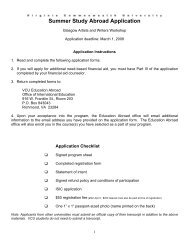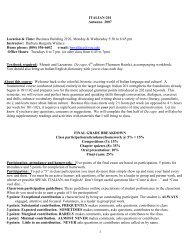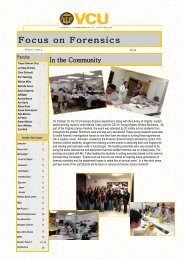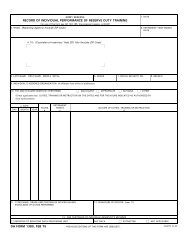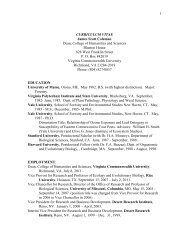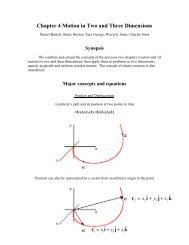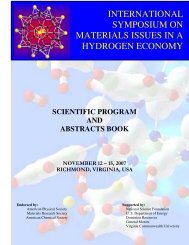Chapter 9 – Systems of Particles
Chapter 9 – Systems of Particles
Chapter 9 – Systems of Particles
Create successful ePaper yourself
Turn your PDF publications into a flip-book with our unique Google optimized e-Paper software.
<strong>Chapter</strong> 9 <strong>–</strong> <strong>Systems</strong> <strong>of</strong> <strong>Particles</strong><br />
Main topics:<br />
• Center <strong>of</strong> Mass<br />
• Newton’s 2 nd Law For a System <strong>of</strong> <strong>Particles</strong><br />
• Linear Momentum/Conservation <strong>of</strong><br />
• <strong>Systems</strong> <strong>of</strong> Varying Mass<br />
Center <strong>of</strong> Mass<br />
The Center <strong>of</strong> mass a point at which you can treat any size object as a point<br />
mass when applying external forces.<br />
In a Boomerang, the center <strong>of</strong> mass is located in it’s internal concavity.<br />
The formula for the center <strong>of</strong> mass is given by<br />
n<br />
rcm = M1<br />
∑ =<br />
i 1<br />
mir<br />
• Tips: When working with center <strong>of</strong> mass problems, break r down into<br />
it’s x, y, and z components and remember that the center <strong>of</strong> mass is<br />
not always in the object.<br />
Newton’s 2 nd Law for a System <strong>of</strong> <strong>Particles</strong><br />
∑ Fext = Macm<br />
Where<br />
1. ∑ Fext is the vector sum <strong>of</strong> all the external forces acting on the system.<br />
Always be sure not to include internal forces, or forces that one part <strong>of</strong> a<br />
system exerts on another part.<br />
2. M is the total mass <strong>of</strong> the system and is constant.
3. acm is the acceleration <strong>of</strong> the center <strong>of</strong> mass <strong>of</strong> the system and not any<br />
other point in the system.<br />
Linear Momentum/Conservation <strong>of</strong><br />
Linear momentum (a vector quantity) <strong>of</strong> a particle is defined as<br />
p = mv<br />
Or momentum is equal to the mass times the velocity. Its SI units are<br />
kilogram-meter per second.<br />
For a system <strong>of</strong> particles, it simply changes to<br />
P = Mvcm<br />
Using momentum, Newton’s second law can be written as<br />
dP<br />
∑ Fext = dt<br />
In any closed, isolated system, the law <strong>of</strong> conservation <strong>of</strong> linear momentum<br />
states that<br />
Pi=Pf<br />
Question: If a system <strong>of</strong> particles has zero momentum does the system<br />
necessarily have zero kinetic energy?<br />
If P = Mvcm = 0 does KE= 2 1 mv² = 0 ?<br />
NO! Momentum is a vector quantity, while kinetic energy is a scalar.<br />
• Tips: Make sure the system is closed and isolated. Be careful that<br />
boundaries <strong>of</strong> the system exclude objects that exert non-conservative<br />
forces. In other words, in that case Pi would not equal Pf.<br />
<strong>Systems</strong> with Varying Mass<br />
Things get a little more complicated when the mass begins to vary, like in a<br />
rocket for example. The book gives two equations for working with rockets.<br />
First Rocket Equation says<br />
Ru = Ma
Where R is the rate at which the fuel is consumed and u is the speed at<br />
which it is being ejected. Thrust, T, is defined as Ru, giving you<br />
T = Ma<br />
Where a is the acceleration at whatever time it’s mass is M.<br />
Second Rocket Equation says<br />
Mi<br />
vf <strong>–</strong> vi = u ln Mf<br />
With Mi as the initial mass and Mf as the final mass<br />
• Tips: <strong>Systems</strong> with varying mass are characteristic <strong>of</strong> rocket<br />
problems.<br />
Links:<br />
The shuttle uses thousands <strong>of</strong> tons <strong>of</strong> fuel<br />
to place only a few tons <strong>of</strong> material into orbit.<br />
Test your skills with momentum conservation with a game <strong>of</strong> pool:<br />
http://members.aol.com/jiping/pool.html<br />
University <strong>of</strong> Wisconsin discussion <strong>of</strong> Linear Momentum/C.M.<br />
http://lupine.physics.wisc.edu/207/lecture10/image-index.html<br />
University <strong>of</strong> Illinois at Urbana-Champaign - Physics notes<br />
http://courses.physics.uiuc.edu/cyberpr<strong>of</strong>-docs/physics/phys101/lect/




